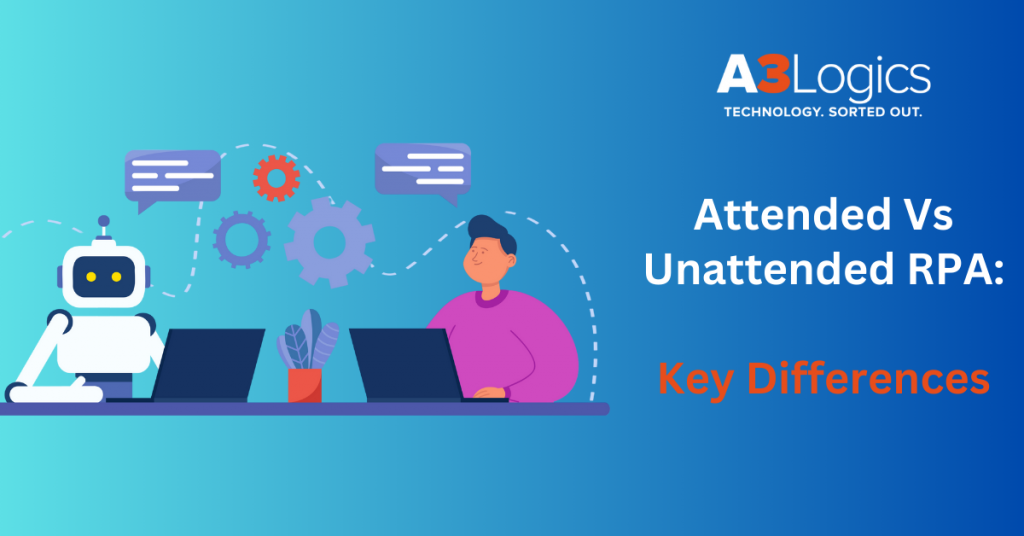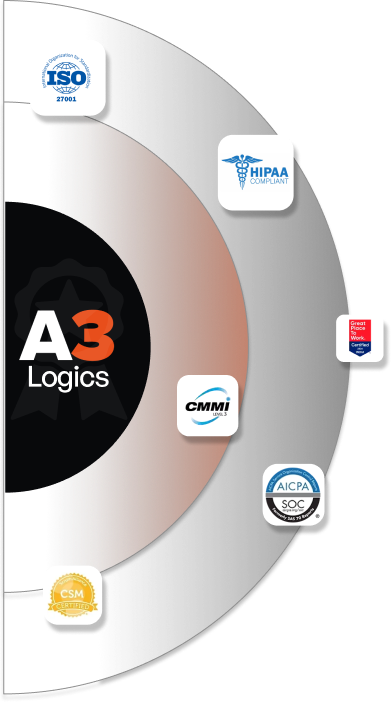Are you thinking about investing in Robotic process automation? Are you confused about how to go about it in terms of attended RPA or unattended RPA? We all know how deploying the RPA appropriately can help you in terms of better work efficiency with fewer errors. It is important that you understand the differences between the attended vs unattended RPA and then proceed ahead with clarity. But, if you are unable to make this decision, then we are here to help you understand all about the clarity. Read on and understand how these RPAs are different and can help your business get its operations optimized to perfection.

Table of Contents
Types of RPA: An Overview
Organizations trying to apply efficient automation plans must first understand the several kinds of RPA , particularly Attended RPA and Unattended RPA. Every kind has different goals and special advantages; therefore, it’s important to select the correct method depending on the company’s needs. Companies can choose wisely that fit their operational objectives by comparing Attended vs Unattended RPA.
What is Attended RPA or Attended Automation?
Attended RPA, sometimes known as attended automation, is made up of bots that support particular activities needing manual intervention by working with human employees. Unlike unattended RPA, which runs on its own, attended bots are activated by a human or specified action inside a workflow. Key features of attended RPA explained with points are listed below:
Human-In-The-Loop Automation
Attended RPA integrates humans into the automation process:
- Users activate bots for particular tasks requiring automation.
- They perform tasks such as data collecting, document comparison, or form submissions.
- The user takes back control to continue the procedure once the bot finishes its portion.
This collaborative approach ensures seamless integration into workflows where automation cannot be entirely autonomous.
Real-Time Assistance
Attended bots act as virtual assistants:
- They provide immediate support during tasks like customer service calls or invoice approvals.
- Bots retrieve and process data in real time, reducing manual effort.
- Employees can focus on decision-making while bots handle mundane tasks.
This enhances productivity and improves the overall employee experience.
Contextual Triggering
Attended RPA is highly responsive:
- Bots are triggered based on user actions or specific conditions within a process.
- For example, a customer service agent can activate a bot to fetch customer details during a call.
- This flexibility makes attended automation ideal for dynamic workflows.
Enhanced Productivity
By automating repetitive tasks:
- Bots reduce errors and time spent on manual processes.
- Employees can concentrate on complex activities requiring human judgment.
- For instance, procurement professionals use bots to compare purchase orders and invoices efficiently.
Collaborative Automation
Attended RPA fosters collaboration:
- Bots work in tandem with users to complete tasks faster.
- They can exchange information with unattended bots for hybrid workflows.
- This synergy enables organizations to optimize both front-office and back-office operations.
RPA is a powerful tool for industries like customer service, healthcare, finance, and HR, where human oversight is essential for successful automation.
Key Statistics About the RPA Industry
The RPA industry is witnessing exponential growth. Here are some key statistics to illustrate this trend:
- Market Growth: The global RPA market is expected to reach $25 billion by 2027, growing at a CAGR of over 30%.
- Adoption Rates: Approximately 80% of organizations are either currently using RPA or planning to implement it.
- Cost Savings: Businesses can save up to 30% on operational costs by adopting RPA solutions.
- Productivity Boost: RPA can increase workforce productivity by up to 50%.
These statistics highlight the transformative potential of RPA and the importance of understanding its various types, including the difference between attended and unattended RPA.
Also read: Must Know RPA Statistics
Attended RPA Benefits
Attended RPA offers several key benefits:
Cost-Effective Operations
RPA reduces operational costs by automating repetitive tasks, saving businesses 25-50% on labor expenses. Unlike human workers, bots operate 24/7 without requiring breaks, vacations, or overtime pay. This continuous operation ensures faster ROI, with many organizations recovering their investment within months.
Enhanced Accuracy and Quality
Bots eliminate human errors by strictly following predefined rules. This leads to 100% accuracy in data processing, minimizing rework and improving overall output quality. For industries like finance and healthcare, error-free operations are critical for compliance and customer satisfaction.
Increased Employee Productivity
By automating mundane tasks, RPA frees employees to focus on strategic activities such as decision-making and innovation. This shift not only boosts productivity but also enhances employee morale by reducing burnout associated with repetitive work.
Faster Task Execution
RPA accelerates task completion by automating processes that would otherwise take hours or days. This speed enables businesses to respond quickly to market demands, gaining a competitive edge in fast-paced industries like retail and logistics.
Scalability and Flexibility
RPA solutions are highly scalable, allowing businesses to handle increased workloads without additional resources. They adapt seamlessly to changing business needs, making them ideal for seasonal fluctuations or rapid growth scenarios.
Improved Compliance
RPA ensures adherence to regulatory requirements by consistently executing tasks according to predefined standards. This reduces the risk of non-compliance penalties and enhances traceability for audits.
Attended RPA Use Cases
Examples of Attended RPA
Attending RPA is particularly beneficial in various industries. Here are some notable use cases:
Customer Service: Enhancing Real-Time Support
RPA revolutionizes customer service by empowering agents with instant access to relevant data during interactions. These bots gather customer information, such as purchase history, demographics, and previous complaints, and present it to representatives in real time.
This enables agents to anticipate queries and deliver personalized solutions swiftly. For example, Cobmax, a sales call center, leveraged IBM’s RPA solution to cut back-office activities by 50%, achieve faster client reporting, and boost monthly sales. By automating repetitive tasks like data retrieval and ticket handling, attended bots reduce average handle time (AHT) and errors, leading to improved customer satisfaction. Organizations can hire mobile app developers to integrate RPA tools into their systems for seamless service delivery.
Healthcare: Streamlining Administrative Efficiency
RPA in healthcare alleviates the burden of repetitive administrative tasks, allowing staff to focus on patient care. These bots automate processes such as claims management, appointment scheduling, and patient record updates. For instance, MD Anderson Cancer Center adopted RPA for secure data transfer and report generation, saving $150,000 annually with an ROI of 650%.
By reducing manual intervention in data handling and billing processes, RPA enhances accuracy and minimizes delays in insurance claims processing. Patients benefit from faster services and personalized care plans. Partnering with a RPA development company ensures tailored solutions that optimize healthcare operations while preventing staff burnout.
Finance: Boosting Operational Accuracy
Attended RPA in finance automates labor-intensive tasks like invoice processing, accounts reconciliation, and financial reporting. Bots ensure error-free data entry, reducing the risk of costly mistakes that can lead to rework or compliance issues. For example, automated invoice processing eliminates format inconsistencies and accelerates approvals. Additionally, RPA streamlines payroll management and tax calculations while maintaining audit trails for regulatory compliance.
Financial institutions like Zurich Insurance utilize RPA to enhance efficiency in claims processing and payment tracking. By integrating attended bots into workflows, organizations can lower operational costs and scale productivity effectively with custom software development services.
Human Resources: Simplifying Onboarding Processes
HR departments leverage attended RPA to automate repetitive tasks such as onboarding new hires, payroll processing, benefits enrollment, and compliance reporting. These bots streamline workflows by handling high-volume data entry and generating accurate reports quickly. For instance, automating onboarding ensures new employees receive timely access to required systems and documents without manual intervention.
Additionally, RPA reduces errors in payroll calculations and benefits administration while enhancing employee satisfaction through faster resolutions of queries. Companies can hire Android app developers to implement RPA solutions that optimize HR operations and improve overall organizational efficiency.
What is Unattended RPA?
Unattended RPA, on the other hand, refers to bots that operate independently without human intervention. These bots can be triggered automatically based on predefined rules or schedules, allowing them to execute entire processes from start to finish. Unattended RPA is ideal for back-office tasks that do not require immediate human oversight.
Benefits of Unattended RPA
Unattended RPA offers numerous advantages:
Continuous Availability
Unattended bots operate autonomously 24/7 without human intervention, ensuring uninterrupted task execution. This is particularly beneficial for global businesses that require round-the-clock operations to maintain competitiveness.
Significant Cost Savings
By automating high-volume tasks, unattended RPA reduces labor costs dramatically while minimizing errors that lead to costly rework. Studies show that companies can achieve up to 300% ROI within the first year of implementation.
Error Reduction and Reliability
Unattended bots execute processes with precision, eliminating variability caused by human fatigue or oversight. This reliability is crucial for industries like healthcare and finance where accuracy is paramount.
Enhanced Operational Efficiency
Unattended RPA streamlines workflows by automating repetitive tasks such as data entry and invoice processing. For example, a healthcare company reduced data entry errors by 70% and improved workflow efficiency by 80% through unattended automation.
Faster Turnaround Times
These bots complete tasks in minutes that would otherwise take hours or days, enabling organizations to meet tight deadlines and adapt quickly to market changes.
Scalability for Growth
Unattended RPA can be scaled effortlessly to accommodate increased workloads during peak times or business expansions. Retailers often deploy additional bots during holiday seasons to manage transaction surges efficiently.
Attended vs Unattended RPA: Key Difference
| Feature | Attended RPA | Unattended RPA |
| Human Involvement | Requires manual trigger | Operates independently |
| Operation Time | Limited to business hours | 24/7 availability |
| Use Cases | Customer service, HR tasks | Data processing, batch jobs |
| Setup Complexity | Generally easier to implement | May require more complex setup |
| Scalability | Less scalable | Highly scalable |
Attended vs Unattended RPA: Which One to Choose When?
Choosing between Attended vs Unattended RPA depends on various factors, including the nature of the tasks, the need for human oversight, and the operational environment. For tasks that require real-time human interaction, Attended RPA is more suitable. Conversely, for repetitive back-office processes that can operate autonomously, Unattended RPA is the ideal choice.Here we take a look in detail:
When to Choose Attended RPA
Attended RPA is perfect for jobs needing real-time human interaction or decision-making. These bots are virtual assistants working with staff members to maximize repetitious chores and raise output. In customer service, for instance, attended bots can access client information right away during calls, hence allowing agents to offer tailored answers.
Similarly, by automating tedious tasks and letting human supervision, they improve processes like claims management in healthcare or onboarding in HR. Front-office operations where human-bot cooperation is vital are best served by attended RPA. To properly include attended RPA into their processes, businesses might work with a bespoke software development firm or engage android app developers.
When to Choose Unattended RPA
Unattended RPA is meant for activities running autonomously without human involvement. These bots are great for back-office tasks, including data entry, invoice processing, and IT system monitoring. Unattended bots, for example, can automatically pull data from emails, save it in databases, and start following processes without human involvement.
Working around the clock, they guarantee great efficiency and accuracy while cutting running expenses. By automating high-volume procedures at scale, unattended RPA helps industries like banking and healthcare greatly. Custom software development can help companies looking for end-to-end automation to implement unattended RPA solutions suited to their requirements for smooth integration and best return on investment.
Future of RPA: The Role of Attended and Unattended RPA in the Future
With both Attended and Unattended RPA playing key roles in digital transformation, the future of RPA seems bright. The features of RPA will be improved by the incorporation of generative AI development company technologies as companies more and more embrace automation. Smarter, more efficient bots able to manage complicated decision-making processes will result from this evolution, hence blurring the border between human and machine interactions.
Final Take
Hopefully, you have got complete clarity about the RPAs and how it is going to affect your business and serve different purposes. The differences between Attended vs Unattended RPA can certainly assist businesses to enhance their operations significantly and pave the way for growth and opportunities. It is important for businesses to understand where these RPAs can help businesses and make it easy for them to choose one for their efficiencies.
You can always consider taking assistance from the experts in the business who can assist you in deciding the RPA to choose. If you are looking for one, then you can consider opting for A3Logics and get all the support you need.







